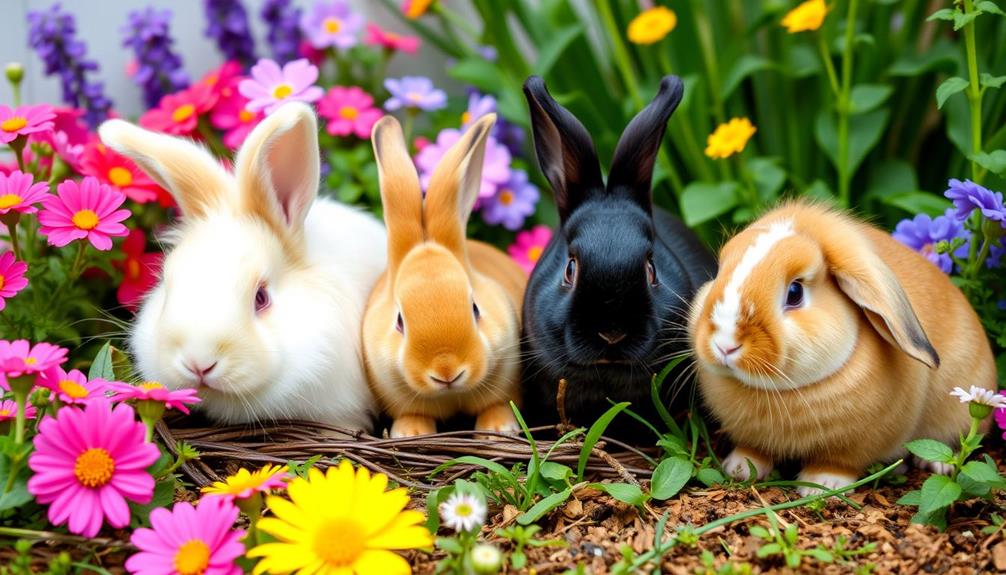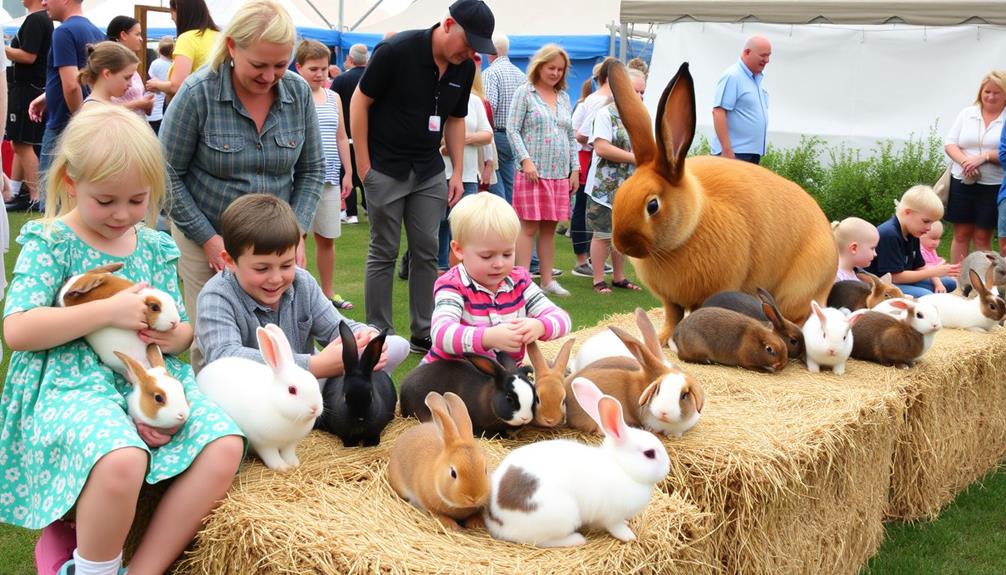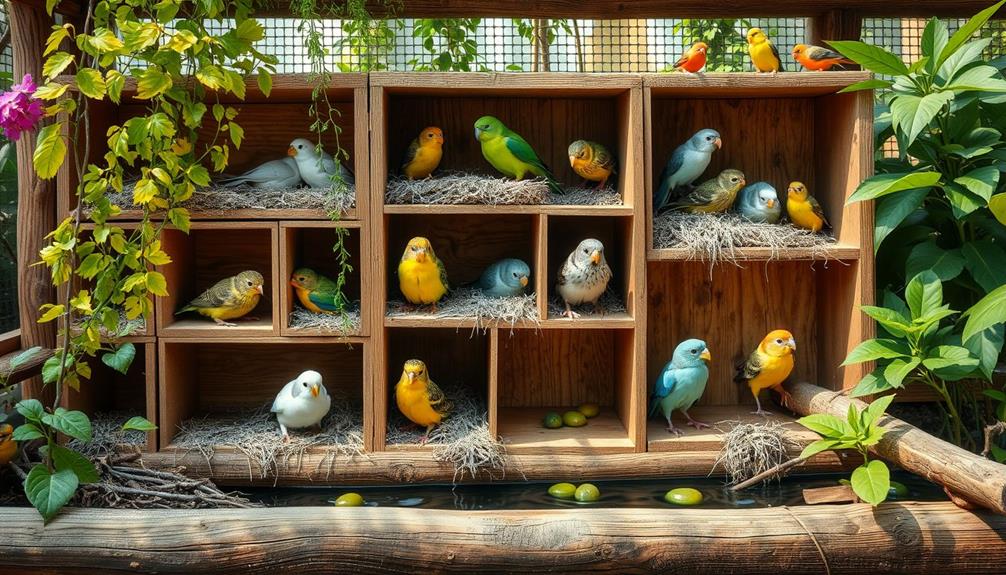When it comes to rabbit breeds, you'll discover a fascinating range from tiny dwarfs to giant Flemish. Dwarfs like the lively Netherland Dwarf weigh about 2 pounds, making them perfect for indoor living. On the other end, Flemish Giants can exceed 25 pounds and are known for their gentle nature. Popular smaller breeds include the affectionate Holland Lop and cuddly Mini Rex. Each breed has unique characteristics and care needs, impacting their temperament and health. For those curious about the best match for your lifestyle, there's much more to uncover about these delightful companions.
Key Takeaways
- Rabbit breeds vary significantly in size, from tiny dwarfs like the Netherland Dwarf to giant breeds such as the Flemish Giant.
- Small breeds such as Mini Rex and Holland Lop are ideal for indoor living, providing companionship and adapting well to family environments.
- Large breeds require more space and specialized care, making them suitable for owners prepared for their unique health needs.
- Proper socialization and emotional well-being are crucial for both small and large rabbits to prevent behavioral issues and promote bonding.
- Regular veterinary checkups and a high-fiber diet are essential for maintaining the health and longevity of all rabbit breeds.
Overview of Rabbit Breeds
Rabbit breeds vary widely, showcasing a fascinating range of sizes, shapes, and temperaments. You'll find everything from tiny dwarf breeds like the Netherland Dwarf, which weighs around 2 pounds, to giant breeds like the Flemish Giant rabbit, that can exceed 25 pounds. This remarkable diversity makes selecting the right rabbit for your home an exciting venture.
Many of these breeds are known for their unique personalities, similar to how various dog breeds exhibit distinct traits, such as the tough dog names suited for strong personalities. Among the popular pet rabbit breeds, you'll discover the Mini Rex, Holland Lop, and Dutch, each known for their friendly nature and manageable sizes, making them ideal for families. These breeds have been developed with companionship in mind, providing warmth and joy to their owners.
Additionally, some breeds serve specific purposes, such as Angora rabbits, which are prized for their soft, luxurious wool. Their unique fur has made them a favorite among crafters and those interested in fiber arts.
It's also worth noting that mixed breed rabbits can display a variety of physical traits and temperaments, resulting from the unpredictable genetic combinations of their parent breeds. This diversity enriches the world of rabbit ownership, ensuring there's a perfect breed for everyone.
Popular Small Rabbit Breeds

When considering small rabbit breeds, you'll find a variety of charming options that fit perfectly into your home. Breeds like the Netherland Dwarf and Mini Rex not only have unique characteristics but also make great companions for families and individuals alike.
These small rabbits can adapt well to indoor living, similar to how cats show signs of emotional attachment to their owners.
Let's explore what makes these miniatures so popular and ideal for various living situations.
Characteristics of Mini Breeds
In the world of small pets, mini breeds of rabbits are a delightful choice for many enthusiasts. These charming companions come in various types, each with unique characteristics that can influence their appeal.
For example, the traits of different breeds may resonate with the idea of astrological compatibility when choosing a pet that fits your personality. The Netherland Dwarf, weighing around 2 pounds, is energetic and sometimes nippy, making it a lively pet that requires your attention.
If you prefer a softer touch, the Mini Rex is known for its velvety fur and cuddly nature, maturing at about 5 pounds. Holland Lops, on the other hand, are characterized by their adorable lopped ears and gentle temperament, typically weighing between 4 to 4.5 pounds.
If you're looking for an exceptionally small breed, consider the Polish rabbit, which matures at about 3.5 pounds and needs careful handling due to its fragile structure.
For first-time rabbit owners, the Dwarf Hotots are an excellent option. Weighing just 2-3 pounds and boasting a distinctive white coat, they require minimal grooming and are easy to care for.
No matter which mini breed you choose, you'll find these small rabbits bring joy and companionship into your home.
Ideal Homes for Dwarfs
What makes an ideal home for dwarf rabbit breeds? First off, these small breeds, like the Netherland Dwarf and Mini Lop, thrive in spaces that accommodate their energetic nature. A cage size of at least 24" x 24" is recommended, giving them enough room to hop around and explore.
Since dwarf breeds enjoy social interaction, it's important to create an environment where they can engage with family members regularly. Incorporating elements of healthy kid play can further enhance their environment, allowing for imaginative play and exploration.
Indoor living suits these rabbits well, especially in households with young children. Just remember, gentle handling is significant, as it helps them feel secure and fosters trust. Regular playtime outside their cage allows them to burn off energy and enjoy their playful personalities.
Diet plays a fundamental role in their well-being too. Make sure to provide a diet rich in hay, fresh vegetables, and limited pellets to support their digestive health.
Popularity of Small Rabbits
Small rabbit breeds have gained immense popularity among pet owners, largely due to their manageable size and engaging personalities.
Additionally, choosing the right pet can be influenced by factors such as proper care and maintenance.
If you're considering getting a small rabbit, here are four popular breeds to think about:
- Polish Rabbit: Weighing around 3.5 pounds, this breed is known for its sweet temperament and delicate structure, making it an adorable companion.
- Holland Lop: With its charming lopped ears, this breed typically weighs between 4 to 4.5 pounds. Its gentle nature makes it a favorite among children.
- Mini Rex: Known for its soft, velvety fur, the Mini Rex matures to about 5 pounds and is friendly, making it an excellent choice for families.
- Mini Lop: Growing to approximately 6 pounds, the Mini Lop is affectionate and thrives in family settings, making it a wonderful pet for individuals and households alike.
Each of these small rabbit breeds brings unique qualities, ensuring that you can find the perfect furry friend to fit your lifestyle.
Whether you prefer a playful Polish rabbit or a cuddly Holland Lop, small rabbits offer joy and companionship.
Characteristics of Large Breeds

When considering large rabbit breeds, you'll notice a significant variation in size and weight, with some like the Flemish Giant reaching up to 50 pounds.
These breeds can also offer unique benefits, similar to how diversification of retirement portfolio reduces risk exposure, as their varied temperaments can complement different living situations.
Their temperament can vary as well, with breeds such as the Spanish Giant being known for their gentle nature.
Additionally, you'll need to pay close attention to their health care requirements to guarantee they thrive in your home.
Size and Weight Variation
Large rabbit breeds, like the Flemish Giant and the Continental Giant, command attention with their impressive size and weight. If you're considering one of these large breeds, here are some key points to keep in mind:
- Weight Range: Flemish Giants typically weigh between 10 to 25 pounds, with some individuals exceeding 50 pounds. Their emotional needs can be as significant as their physical ones, much like managing relationships with borderline mothers who require understanding and empathy.
- Length: These rabbits can stretch from 2 to 4 feet long, with record-holding Continental Giants measuring over 4 feet.
- Living Space: Due to their size, they require larger living spaces compared to smaller rabbit breeds.
- Care Costs: Expect increased food and care costs, as their gentle nature demands more attention and resources.
While their size is impressive, it also comes with health considerations. Larger breeds are prone to issues like sore hocks and arthritis due to their weight.
Consequently, you'll need to be prepared for the special care these rabbits require. Choosing a large breed like the Giant Chinchilla or Spanish Giant means committing to a unique set of responsibilities, but their gentle nature can make them wonderful companions.
Temperament and Behavior Traits
Giant rabbits, like the Flemish Giant and Checkered Giant, are celebrated for their calm and gentle nature, making them ideal companions for families.
These gentle giants possess a docile nature that allows them to thrive in a home environment. With their unique temperament, they can be quite sociable and affectionate, often forming strong bonds with you when properly socialized from a young age.
Additionally, their spacious living requirements can be likened to the comprehensive professional services offered to create functional spaces for various needs.
You'll find that larger breeds generally exhibit less energetic behavior than smaller breeds, which can simplify their care. While each giant rabbit has its unique temperament, some may display playful or quirky traits, adding a delightful touch to their personality.
To help them flourish, attentive socialization and training are fundamental.
It's important to remember that proper care, including regular exercise and mental stimulation, is essential for preventing behavioral issues.
Giant rabbits thrive on interaction and engagement with their human families, so investing time in activities together is imperative.
With the right environment and care, you'll discover just how rewarding it's to have a gentle giant as part of your family.
Health Care Requirements
Proper care requirements for giant rabbit breeds often include specialized attention to their health needs. Their large size means they face unique challenges, so staying proactive is essential.
Understanding the importance of emotional well-being during changes is also fundamental for both the owners and the pets.
Here are four key health care requirements to keep in mind:
- Diet with plenty of high-fiber hay: This is fundamental for preventing digestive issues like hairball blockages and gastrointestinal stasis. Make sure they've constant access to it.
- Regular grooming: For breeds like the Giant Angora, grooming is critical to prevent matting and hairball complications. Their dense fur can lead to serious digestive problems if not managed properly.
- Health concerns management: Keep an eye out for sore hocks and arthritis, common issues in larger breeds. Providing soft bedding and conducting regular foot checks can help alleviate these risks.
- Vet checkups: Regular veterinary checkups are important for monitoring health and addressing any potential problems early. This can greatly contribute to the longevity of your giant rabbit, which usually lives from 5 to 12 years.
Unique and Rare Rabbit Breeds

Exploring the world of unique and rare rabbit breeds reveals a fascinating array of characteristics and histories.
Take the Argente St. Huberts, for example. This breed, established in France during the 1880s, showcases heavily silvered black agouti-based fur that makes it truly distinctive. The cultural significance of breeds like the Argente St. Huberts can be likened to the importance of ancient Hopi villages, with unique traits reflecting deep-rooted traditions.
If you're looking for adaptability, the Baladi breed from the Middle East is a medium-sized gem known for its hardiness, thriving in various environments.
Then there's the Bauscat, an Egyptian breed bred specifically for meat production. With its muscular build, it's become a favorite among breeders.
For those seeking gentle companions, the Beige rabbit stands out with its light-sandy-colored silky fur and sweet demeanor, making it perfect for families.
Lastly, consider the Belgian rabbit, reminiscent of the wild European hare. It's not just unique; its active nature and trainability make it an appealing choice for those who enjoy lively pets.
Each of these rare breeds showcases remarkable adaptations that make them special, whether for companionship, aesthetics, or practical purposes. You'll find that unique rabbits can bring a diverse touch to your life!
Breeding Practices and Considerations

Understanding the intricacies of breeding practices is crucial for anyone looking to enhance their rabbitry. Proper management and knowledge can make all the difference in producing healthy, robust rabbits. Here are some key considerations:
- Use a Large Doe: When breeding, opt for a larger doe, like a Flemish Giant. This can guarantee safer kindling and minimize birthing difficulties.
- Monitor for Genetic Defects: Be aware of potential genetic defects, especially when crossbreeding small dwarf breeds. These defects can affect the health and temperament of your rabbits.
- Prevent Accidental Breedings: Mixed breeds can lead to unpredictable size outcomes, so careful housing management is essential. Confirm that your rabbits are housed appropriately to avoid unintended pairings.
- Timing for Sale: Young rabbits should ideally be sold at 8 weeks old instead of 5 weeks. This allows for better health monitoring and guarantees that the new owners receive properly developed rabbits.
Health and Care Requirements

When it comes to keeping rabbits healthy and happy, attention to their care requirements is paramount. A proper diet is essential for their health, so make certain to provide high-fiber hay, fresh greens, and fortified pellets. This will support their digestive health and overall well-being.
Regular veterinary checkups are equally important, especially for young rabbits from questionable breeding practices. These checkups help detect potential issues early, allowing for timely intervention.
Larger breeds, like Flemish Giants, have specific health concerns. They're prone to sore hocks and increased arthritis risk, so guarantee they've soft bedding and perform regular foot checks.
Keep a close eye on young rabbits for weight gain and any signs of illness. If your rabbit isn't eating or pooping within 12-24 hours, consult a veterinarian immediately.
Grooming is also critical; regular brushing helps prevent matting and reduces shedding.
Additionally, social interaction is fundamental for all breeds; rabbits thrive on engagement with their owners and need ample space to exercise and explore.
Size Expectations and Variations

Rabbit owners quickly realize that size expectations can vary widely among different breeds and mixed breeds. Understanding these variations is essential to choosing the right rabbit for your home.
Here are some important points to reflect on:
- Mixed Breeding: Offspring from a mix of breeds, like a Flemish Giant and a Netherlands Dwarf, can weigh anywhere between 2 to over 20 pounds.
- Baby Size: At birth, baby bunnies can be tiny enough to fit in a teacup, but their final size becomes clearer as they grow.
- Genetic Factors: The genetic background of mixed breed rabbits plays a significant role in determining their adult size, making predictions tricky.
- Space Requirements: Larger breeds, such as the Flemish Giant, typically require more space and specialized care, impacting your housing setup and overall care approach.
When reflecting on rabbits, think about how size expectations will affect your living arrangements and lifestyle.
Whether you opt for smaller breeds or Giant rabbit breeds, being informed will lead to a more fulfilling experience for both you and your furry friend.
Community Insights and Experiences

Many rabbit enthusiasts share a wealth of insights and experiences that can guide new owners in steering through the complexities of rabbit care. One common topic in the community is the skepticism surrounding breeders who sell young rabbits at just 5 weeks old. Many members emphasize that this age is too early for proper socialization and health monitoring, leading to potential health concerns down the line.
When it comes to mixed breed rabbits, the discussions reveal an unpredictable range of sizes, especially when breeds like Flemish Giants and Netherlands Dwarfs are mixed. You'll find that many community insights highlight the unique physical traits these rabbits can develop, such as variations in ear length and head size, sparking curiosity among enthusiasts.
The online community serves as a valuable platform for sharing anecdotes about mixed breed rabbits. Many participants provide specific examples of how their pets have evolved in size and temperament over time.
Most importantly, members consistently stress the need for professional veterinary advice for any health concerns, particularly for young rabbits from questionable breeding backgrounds, ensuring your furry friend's well-being.
Cultural Significance of Rabbits

Across cultures, rabbits hold a unique place in human history, symbolizing fertility, rebirth, and cleverness. Their domestication over a thousand years has allowed them to serve various roles in agriculture and companionship, enriching our lives and cultural symbolism.
Here are four key aspects of their significance:
- Fertility and Rebirth: Often associated with springtime celebrations, rabbits, like the Easter Bunny, represent renewal and the cycle of life.
- Folklore and Literature: Tales like "The Tortoise and the Hare" not only entertain but also shape our understanding of speed and agility, highlighting rabbits' cleverness.
- Cultural Myths: In Native American traditions, the trickster rabbit symbolizes adaptability and cleverness, showcasing the animal's importance in various mythologies.
- Rabbit Breeds: The 19th century saw a rise in rabbit shows and breeding associations, reflecting an appreciation for the diverse breeds of rabbits and their roles in agriculture.
These elements reveal how deeply intertwined rabbits are with human culture, highlighting their lasting impact through symbolism, stories, and community involvement.
Frequently Asked Questions
Do Flemish Giants Get Along With Smaller Rabbits?
Yes, Flemish Giants can get along with smaller rabbits if you introduce them slowly and supervise interactions. Make certain each rabbit has its own space and resources to minimize territorial disputes and guarantee a peaceful coexistence.
What Breed of Rabbit Is the Most Affectionate?
If you're looking for an affectionate rabbit, consider a Holland Lop or Mini Rex. Both breeds are known for their friendly nature and love for human interaction, making them great companions for you and your family.
What Breed of Rabbit Is the Most Affectionate?
You might think all rabbits are cuddly, but some breeds truly shine in affection. Holland Lops and Mini Rex stand out for their gentle, loving nature, making them perfect furry companions for you and your family.
What Is the Cutest Dwarf Rabbit Breed?
When you think of the cutest dwarf rabbit breed, the Netherland Dwarf often comes to mind. With its tiny size and lively personality, it steals hearts and makes a delightful companion for anyone.
Conclusion
As you explore the diverse world of rabbit breeds, you'll find yourself enchanted by the tiny, fluffy dwarfs hopping playfully alongside the majestic Flemish giants, their ears flopping like sails in the wind. Each breed tells a story, from their unique traits to the gentle thump of their feet on the ground. By understanding their needs and celebrating their quirks, you can create a vibrant, loving home that mirrors the beauty and charm of these delightful creatures.










